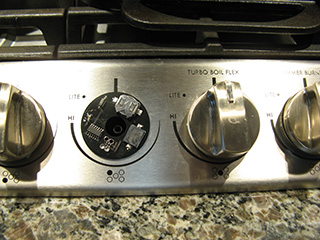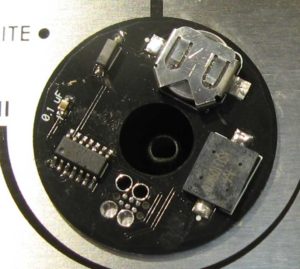
Over the last year, my wife and I have left our gas stove on twice. Once, the burner was not lit, so we woke up to a kitchen full of gas. Not good.
 I decided we needed an alarm to warn us if the stove is on. There are commercial alarms available, but they work by detecting heat. That wouldn’t handle the situation where the gas is on but the burner is not lit.
I decided we needed an alarm to warn us if the stove is on. There are commercial alarms available, but they work by detecting heat. That wouldn’t handle the situation where the gas is on but the burner is not lit.
So I designed my own solution. It’s a circuit board that sits under the burner knob, held on by double-sided tape on the back. The burner knob has a small magnet stuck to it, and when the burner is off, the magnet is positioned over a Normally Closed reed switch.
When the knob is turned, the reed switch closes and power flows from a coin cell battery to a Microchip PIC 8 bit microcontroller. The PIC beeps a transducer once to announce it’s working, then sets a timer. Every 10 minutes, the PIC beeps again, getting more insistent as time goes on: 3 beeps after the first 10 minutes, 6 beeps after the second 10 minutes, 9 beeps after the third, and so on.
It’s a very simple circuit and very simple code. You can download the DipTrace schematic and board layout as well as the code (use Microchip’s MPLAB X development environment). If you make this yourself, be sure to compare the board layout to your stove’s knobs: you want the board diameter to be small enough to be hidden under the knob, and the center hole big enough to accommodate the knob’s shaft. Also, note that I use a Tag-Connect TC2030 MCP cable to connect my ICSP programmer to the board. You’ll either need to get one of these cables (highly recommended!) or alter the design to use Microchip’s traditional 6 pin programming header.


Neat. But I have another solution: Electric stove. I don’t like the idea of gas in the house.
Of course you also have the problem of pranksters setting false fire alarms. Great invention to solve this problem:
http://blog.modernmechanix.com/fire-box-traps-pranksters/
I think that alarm is one hell of a Good Idea. I have had our pilot lights go out on numerous occasions over the years.
I really appreciate the safety tips
@Dave, you must not like to cook. Electric is how I burned out my kitchen 20 years ago.
Left a burner on and left the house, with a pot of stew on.
I like this idea, but 10 minutes is not enough time to cook anything.
A decreasing time starting at 20 minutes, 15, 10, 5,5,5,5…..
Makes more sense to me.
But that’s how I cook.
I’ve posted the source code. You’re certainly welcome to modify the timing. But I’ve found the current setting works well. After 10 minutes, it beeps three times. After 20, it beeps 6 times. It’s not something I find annoying. It fact, it’s reassuring.
Would you please add a png or pdf file to your schematic file.
Done.
This would work on my electric range, since it’s a countertop surface range made of black glass (the oven is elsewhere). I can put the circuitry below the glass and remotely wire the reed switch to rest under the knob. Covering the top and sides of the switch with a glob of glue will make it easier to clean. Great idea — thank you!
I thought about getting something like this from 2GIG: https://www.2gig.com/products/sensors/stove-grill-guard-sensor/ , but this would be an awesome alternative.
Nice job!
In Korea they have gas stove tops that have metal rods in the center of each burner and if it is not pressed down by some sort of cookware it will shut off the gas automatically after a short time. Where can I find stove like this in the US? I can’t find them anywhere.